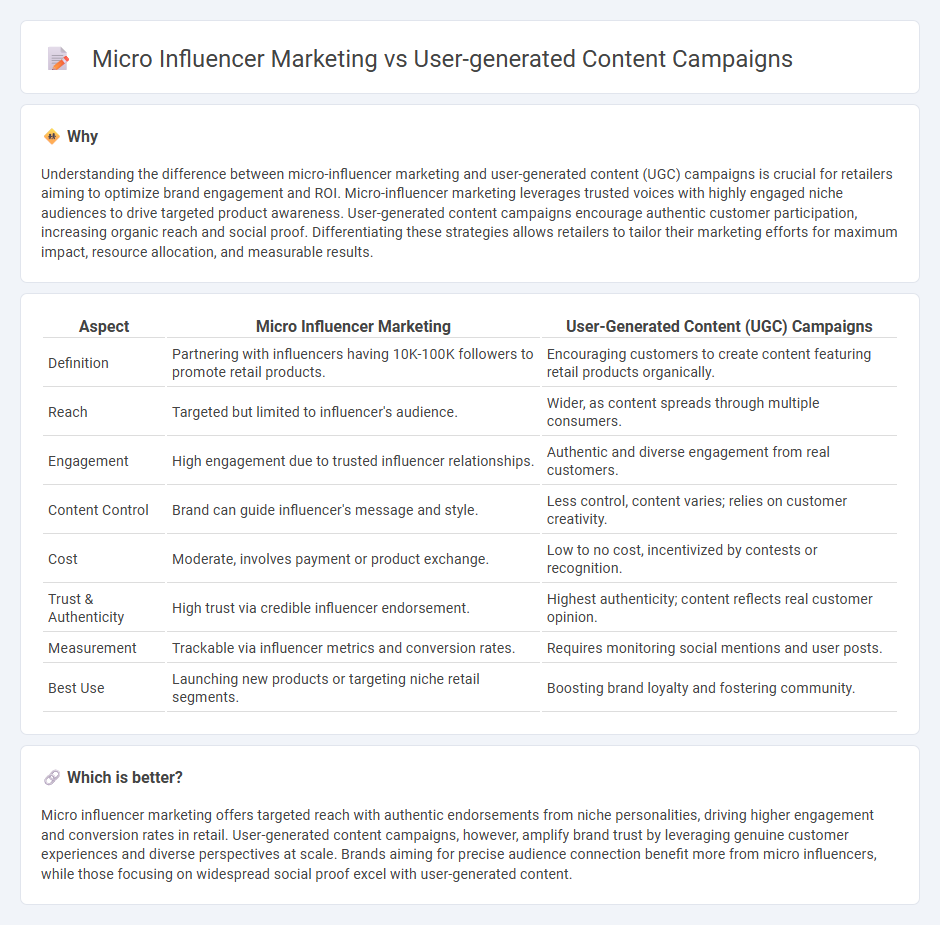
Micro influencer marketing leverages niche creators with targeted audiences to drive authentic engagement and brand trust, often resulting in higher conversion rates. User-generated content campaigns encourage customers to share their experiences, fostering community involvement and organic brand advocacy across social platforms. Explore the differences and benefits of these strategies to enhance your retail marketing success.
Why it is important
Understanding the difference between micro-influencer marketing and user-generated content (UGC) campaigns is crucial for retailers aiming to optimize brand engagement and ROI. Micro-influencer marketing leverages trusted voices with highly engaged niche audiences to drive targeted product awareness. User-generated content campaigns encourage authentic customer participation, increasing organic reach and social proof. Differentiating these strategies allows retailers to tailor their marketing efforts for maximum impact, resource allocation, and measurable results.
Comparison Table
| Aspect | Micro Influencer Marketing | User-Generated Content (UGC) Campaigns |
|---|---|---|
| Definition | Partnering with influencers having 10K-100K followers to promote retail products. | Encouraging customers to create content featuring retail products organically. |
| Reach | Targeted but limited to influencer's audience. | Wider, as content spreads through multiple consumers. |
| Engagement | High engagement due to trusted influencer relationships. | Authentic and diverse engagement from real customers. |
| Content Control | Brand can guide influencer's message and style. | Less control, content varies; relies on customer creativity. |
| Cost | Moderate, involves payment or product exchange. | Low to no cost, incentivized by contests or recognition. |
| Trust & Authenticity | High trust via credible influencer endorsement. | Highest authenticity; content reflects real customer opinion. |
| Measurement | Trackable via influencer metrics and conversion rates. | Requires monitoring social mentions and user posts. |
| Best Use | Launching new products or targeting niche retail segments. | Boosting brand loyalty and fostering community. |
Which is better?
Micro influencer marketing offers targeted reach with authentic endorsements from niche personalities, driving higher engagement and conversion rates in retail. User-generated content campaigns, however, amplify brand trust by leveraging genuine customer experiences and diverse perspectives at scale. Brands aiming for precise audience connection benefit more from micro influencers, while those focusing on widespread social proof excel with user-generated content.
Connection
Micro influencer marketing enhances retail brand authenticity by leveraging niche audiences that resonate with genuine user-generated content (UGC). Retailers benefit from increased engagement and trust when micro influencers encourage customers to create and share UGC, reinforcing community-driven promotion. Combining micro influencer strategies with UGC campaigns drives organic reach and boosts conversion rates through relatable and credible brand experiences.
Key Terms
User-Generated Content Campaigns:
User-generated content (UGC) campaigns drive authentic brand engagement by leveraging real customer experiences, increasing trust, and boosting conversion rates through relatable content. Brands using UGC benefit from diverse content pools, cost-effective marketing, and enhanced social proof across social media platforms. Discover how UGC campaigns can transform your marketing strategy for deeper audience connection.
Customer Reviews
Customer reviews in user-generated content campaigns provide authentic, diverse feedback that enhances brand credibility and trust across platforms. Micro influencer marketing leverages niche influencers to generate targeted customer reviews, driving engagement through personalized recommendations within their loyal communities. Explore how integrating these strategies can amplify your customer review impact and boost conversion rates.
Branded Hashtags
User-generated content campaigns leverage branded hashtags to encourage organic customer engagement and authentic brand storytelling, boosting social proof and expanding reach. Micro influencer marketing uses branded hashtags to track niche influencer contributions and amplify targeted audience interaction with higher conversion potential. Explore detailed strategies to maximize branded hashtag impact for both campaigns and micro influencer marketing.
Source and External Links
21 User-Generated Content Examples For Your Next Marketing Campaign - Creating a user-generated content (UGC) campaign involves setting clear objectives, choosing the right platform, providing incentives, promoting the campaign, engaging with participants, moderating submissions, measuring success, and encouraging authentic, video-based content to build meaningful connections with the audience.
UGC Content 101: A Comprehensive Introduction - User-generated content campaigns leverage authentic content created by customers, brand loyalists, social media followers, and specialized UGC creators to boost trust and conversion rates, as 92% of consumers prefer genuine customer experiences over traditional ads.
10 User Generated Content Campaigns That Actually Worked - Successful UGC campaigns include calls-to-action like hashtags or tags to consolidate content and increase sharing, and use the insights from UGC to inform product development and marketing positioning, helping brands grow their community and customer loyalty.
 dowidth.com
dowidth.com